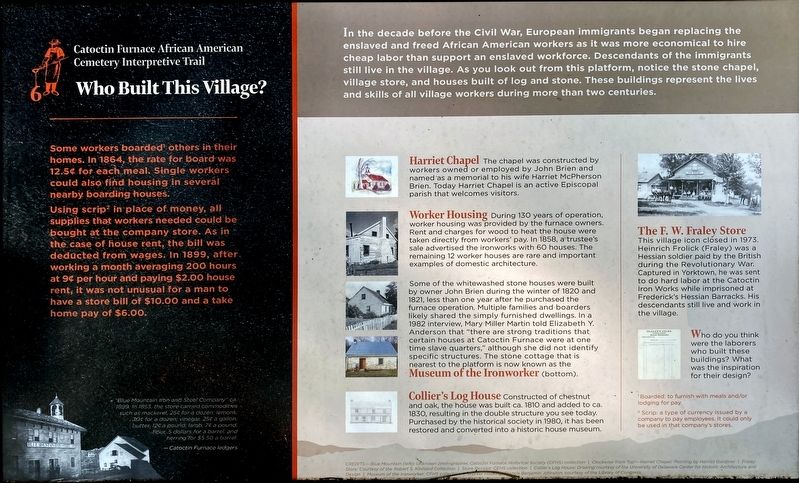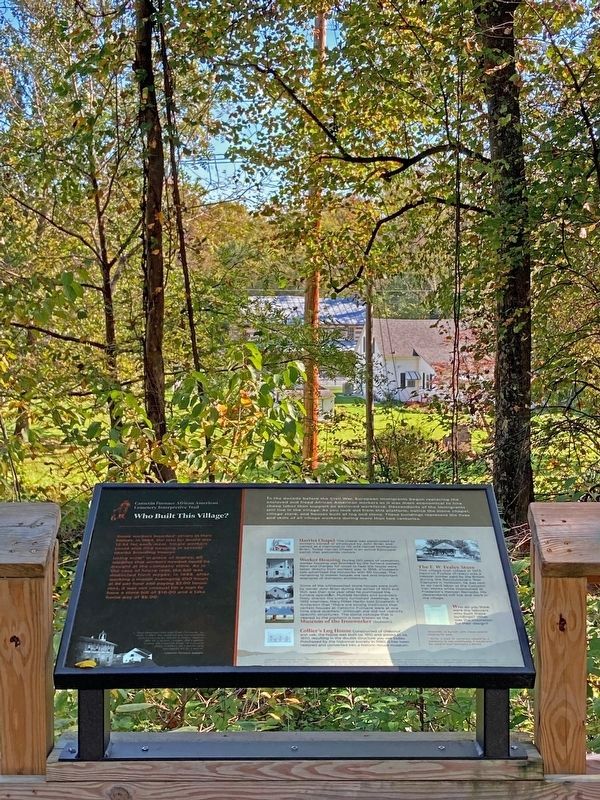Near Thurmont in Frederick County, Maryland — The American Northeast (Mid-Atlantic)
Who Built this Village?
Catoctin Furnace African American Cemetery Interpretive Trail
Some workers boarded1 others in their homes. In 1864, the rate for board was 12.5˘ for each meal. Single workers could also find housing in several nearby Boarding Houses.
Using scrip2 in place of, money, all supplies that workers needed could be bought at the company store. As in case of house rent, the bill was deducted from wages. In 1899, after working a month averaging 200 hours at 9˘ per hour and paying $2.00 house rent it was not unusual for a man to have a store bill of $10.00 and a take home pay of $6.00.
In the decade before the Civil War, European immigrants began replacing the enslaved and freed African American workers as it was more economical to hire cheap labor than support an enslaved workforce. Descendants of the immigrants still live in the village. As you look out from this platform, notice the stone chapel, village store, and houses built of log and stone. These buildings represent the lives and skills of all village workers during more than two centuries.
Harriet Chapel. The chapel was constructed by workers owned or employed by John Brien and named as a memorial to his wife Harriet McPherson Brien. Today Harriet Chapel is an active Episcopal parish that welcomes visitors.
Worker Housing. During 130 years of operation, worker housing was provided by the furnace owners. Rent and charges for wood to heat the house were taken directly from workers' pay. In 1858, a trustee's sale advertised the ironworks with 60 houses. The remaining 12 worker houses are rare and important examples of domestic architecture.
Some of the whitewashed stone houses were built by owner John Brien during the winter of 1820 and 1821, less than one year after he purchased the furnace operation. Multiple families and boarders likely shared the simply furnished dwellings. In a 1982 interview, Mary Miller Martin told Elizabeth Y. Anderson that "there are strong traditions that certain houses at Catoctin Furnace were at one time slave quarters," although she did not identify specific structures. The stone cottage that is nearest to the platform is now known as the Museum of the Ironworker (bottom).
Collier's Log House. Constructed of chestnut and oak, the house was built ca. 1810 and added to ca. 1830, resulting in the double structure you see today. Purchased by the historical society in 1980, it has been restored and converted into a historic house museum.
The F.W. Fraley Store. This village icon closed in 1973. Heinrich Frolick (Fraley) was a Hessian soldier paid by the British during the Revolutionary War. Captured in Yorktown, he was sent to do hard
labor at the Catoctin Iron Works while imprisoned at Frederick' Hessian Barracks. His descendants still live and work in the village.
Who do you think were the laborers who built these buildings? What was the inspiration for their design?
1Boarded: to furnish with meals and/or lodging for pay.
2Scrip: a type of currency issued by a company to pay employees. It could only be used in that company's stores.
Erected by Maryland Historical Trust; Maryland Commission on African American History and Culture; Maryland Park Service, Maryland Department of Natural Resources. (Marker Number 6.)
Topics and series. This historical marker is listed in these topic lists: African Americans • Cemeteries & Burial Sites • Industry & Commerce • War, US Revolutionary. In addition, it is included in the Maryland Historical Trust series list. A significant historical year for this entry is 1864.
Location. 39° 34.75′ N, 77° 26.086′ W. Marker is near Thurmont, Maryland, in Frederick County. Marker can be reached from Catoctin Furnace Road (Maryland Route 806) just south of Catoctin Hollow Road, on the right when traveling south. Touch for map. Marker is at or near this postal address: 12610 Catoctin Furnace Rd, Thurmont MD 21788, United States of America. Touch for directions.
Other nearby markers.
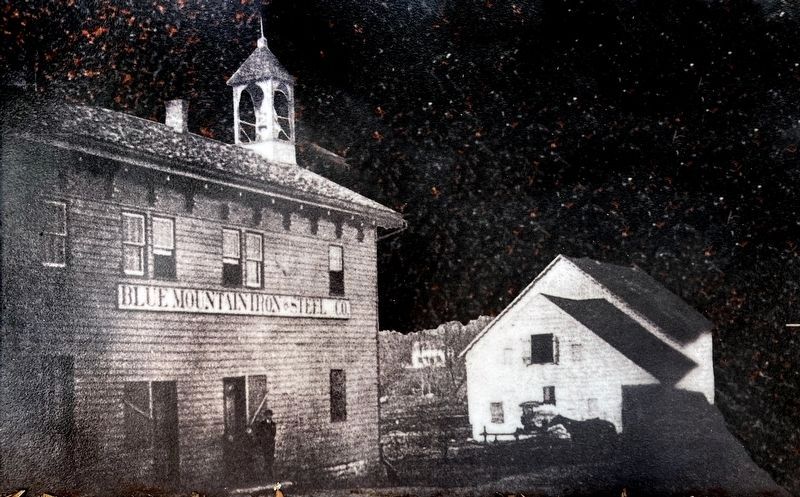
Photographed By Allen C. Browne, October 18, 2021
3. “Blue Mountain Iron and Steel Company” ca. 1899.
In 1853, the store carried commodities such as mackerel, 25˘ for a dozen; lemons 30˘ for a dozen; vinegar, 25˘ a gallon; butter, 12˘ a pound; lamb, 7˘ a pound; flour, 5 dollars for a barrel; and herring for $5.50 a barrel.
— Catoctin Furnace Ledgers.
— Catoctin Furnace Ledgers.
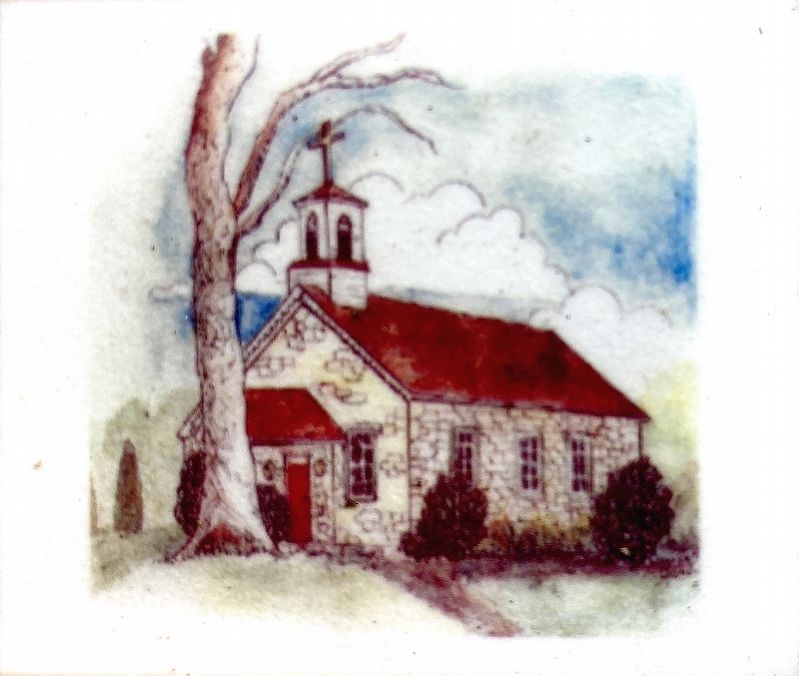
Photographed By Allen C. Browne, October 21, 2021
4. Harriet Chapel
The chapel was constructed by workers owned or employed by John Brien and named as a memorial to his wife Harriet McPherson Brien. Today Harriet Chapel is an active Episcopal parish that welcomes visitors. Painting by Harriet Gardiner.Close-up of image on marker
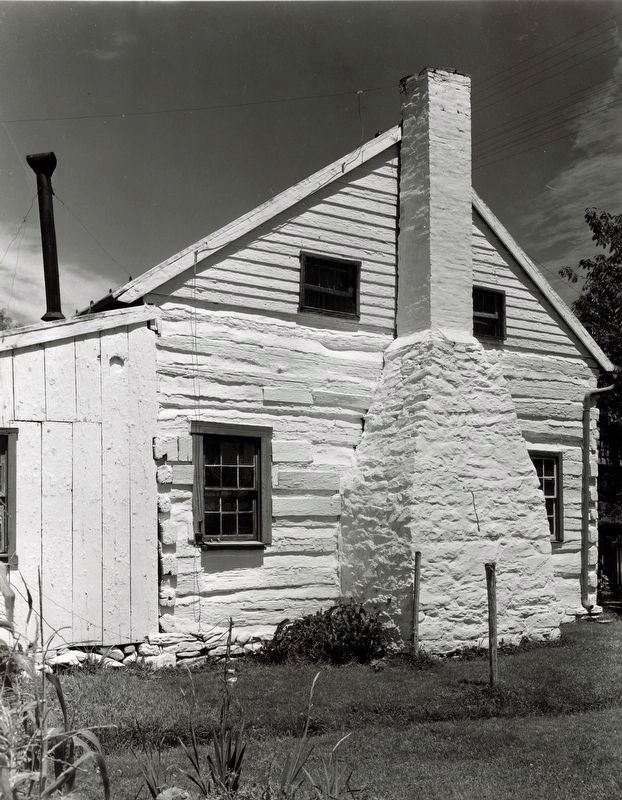
Library of Congress
5. Worker Housing During 130 Years of Operation.
Worker housing was provided by the furnace owners. Rent and charges for wood to heat the house were taken directly from workers' pay. In 1858, a trustee's sale advertised the ironworks with 60 houses. The remaining 12 worker houses are rare and important examples of domestic architecture. Photo by Frances Benjamin Johnston 1936-1937.
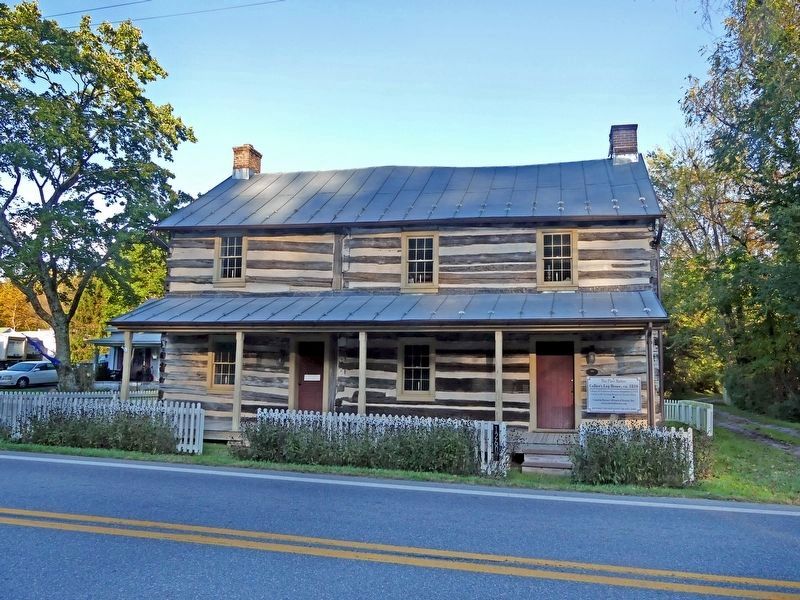
Photographed By Allen C. Browne, October 18, 2021
6. Collier's Log House
12607 Catoctin Furnace Road
12607 Catoctin Furnace Road
Constructed of chestnut and oak, the house was built ca. 1810 and added to ca. 1830, resulting in the double structure you see today. Purchased by the historical society in 1980, it has been restored and converted into a historic house museum.
Credits. This page was last revised on October 26, 2021. It was originally submitted on October 25, 2021, by Allen C. Browne of Silver Spring, Maryland. This page has been viewed 214 times since then and 9 times this year. Photos: 1, 2, 3, 4, 5, 6. submitted on October 25, 2021, by Allen C. Browne of Silver Spring, Maryland. • Devry Becker Jones was the editor who published this page.
